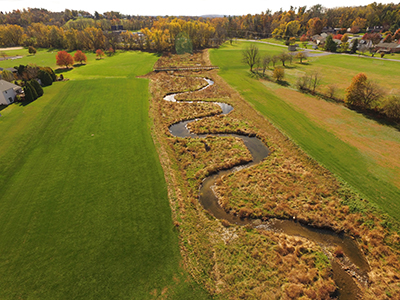Floodplain Restoration
Background
 RPCO possesses training, staffing and coordination abilities to handle specialized projects such as those proposing Floodplain Restoration (FPR) for new land development and to comply with stormwater management requirements.
RPCO possesses training, staffing and coordination abilities to handle specialized projects such as those proposing Floodplain Restoration (FPR) for new land development and to comply with stormwater management requirements.
There are a few reasons why FPR is gaining “special” attention. First, DEP has been heavily involved in projects and research dealing with Legacy Sediments*.
*Legacy sediment (LS) is depositional bodies of sediment inherited from the increase of human activities since the Neolithic. These include a broad range of land use and land cover changes, such as agricultural clearance, lumbering and clearance of native vegetation, mining, road building, urbanization, as well as alterations brought to river systems in the form of dams and other engineering structures meant to control and regulate natural fluvial processes (erosion, deposition, lateral migration, meandering). A.K.A. post-European floodplain sediment or post settlement alluvium.
Much of this attention has stemmed from research that was conducted at nearby colleges (Franklin and Marshall College and
University of Delaware) and the historic prevalence of mill dams throughout the Commonwealth. DEP has been working towards addressing LS issues – specifically in the Bureau of Waterways Engineering and Wetlands (BWEW). LS are looked upon as a major contributing factor to sediment pollution in the Chesapeake Bay (among other watersheds) and has led to the creation of the Legacy Sediment Workgroup and
tributary strategies which include FPR as an innovative BMP proposal. Additional information can be found in the STAC Publication (2017) on
Legacy Sediment, Riparian Corridors and Total Maximum Daily Loads.
Another reason why FPR is gaining attention is because of the demands and search for practical stormwater best management practices (BMPs) to help control the rate, volume and water quality of runoff from site development. DEP has a
Stormwater BMP Manual (2006) - soon to be updated. The original manual was a first attempt to lay out the available BMPs but it was in no way proposed to be an all-inclusive document. The stormwater industry has been making dramatic advances in the past 15-20 years – some are covered in the manual, but many are not. DEP’s Stormwater BMP Manual already had a section on Floodplain Restoration (BMP 6.7.4)– however it was light on design details. In the past couple years, more specific design information has emerged.
Contact Information
Address:
PA Department of Environmental Protection
Regional Permit Coordination Office
400 Market Street
10th Floor Rachel Carson State Office Building
Harrisburg, PA 17101
Email:
RA-EPREGIONALPERMIT@pa.gov
Phone: 717-772-5987